So, in the recent trip to New York (the state, not the city,) the schedule was tight and there were several obligations, so I had only tentative plans to get out to a couple of areas to do some exploring and/or photography, and they never came to pass. One of those plans was fossil hunting, since there are several areas close to where I was that were surprisingly easy to find fossils within.
However, when out with family on Owasco Lake, there was a channel bordered by huge stones piled up for erosion control, and my brother and I entertained ourselves by skimming over those to see what could be found, my brother taking the time to point out to my nieces and their kids how to spot likely fossil-bearing stone. I came up with a moderate-sized rock with an interesting pattern, a long narrow band crossing the surface with a distinctive difference in coloration and texture. On turning the stone over, I found a matching band of white crystal, and so, with a couple of heavy whacks against a big rock, I managed to split the stone open along the fossil which passed clean through it, revealing a probably-coral growth that had crystallized into something resembling white quartz, but with a couple of tiny patches of purple which put me in mind of amethyst – I’m not at all into geology or crystals, so these are only impressions. The half bearing the fossil had broken as well, and so one half went to my niece, and I kept the other. Unfortunately my niece got distracted and mislaid hers within the hour, so I gave her mine.
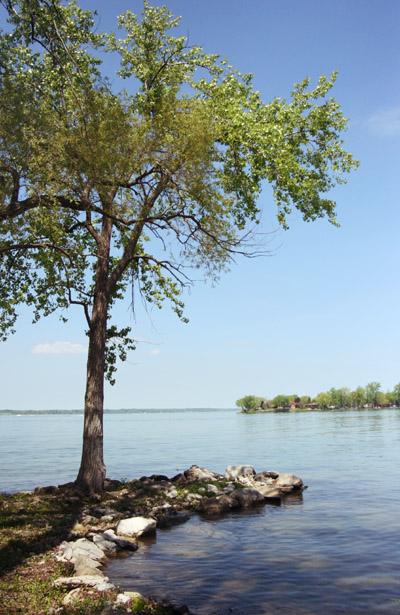 The following day at Cayuga lake, I was poking along a shoreline made up of more erosion control, only older and more haphazard, this being done by a homeowner quite a few decades ago to form the base of a dock. I was barely trying, but abruptly spotted a stone simply oozing (okay, wrong word) with fossils, about 15 cm across. The image here is not exactly where I found it, being a handful of meters to one side, but shows the conditions. The stones used were very likely all locally found, but not necessarily evidence of local geology; the Finger Lakes are glacially-cut, and some of the stones to be found in the area had been carried a long way by the glaciers. So while any rock found in situ, or at least near a matching rock face that it broke away from, will be from a rough time period, this cannot be considered indicative of anything loose, especially something that is noticeably different in makeup from other rock in the vicinity. The bedrock in that area of NY is from the border of the Devonian and Silurian periods, somewhere around 416 million years old, but the glaciers cut through much, much later than that. I made sure to take my find along with me, which got the attention of TSA because there’s no doubt it was noticeably opaque to X-rays – in fact, I would have liked to have seen what they came up with.
The following day at Cayuga lake, I was poking along a shoreline made up of more erosion control, only older and more haphazard, this being done by a homeowner quite a few decades ago to form the base of a dock. I was barely trying, but abruptly spotted a stone simply oozing (okay, wrong word) with fossils, about 15 cm across. The image here is not exactly where I found it, being a handful of meters to one side, but shows the conditions. The stones used were very likely all locally found, but not necessarily evidence of local geology; the Finger Lakes are glacially-cut, and some of the stones to be found in the area had been carried a long way by the glaciers. So while any rock found in situ, or at least near a matching rock face that it broke away from, will be from a rough time period, this cannot be considered indicative of anything loose, especially something that is noticeably different in makeup from other rock in the vicinity. The bedrock in that area of NY is from the border of the Devonian and Silurian periods, somewhere around 416 million years old, but the glaciers cut through much, much later than that. I made sure to take my find along with me, which got the attention of TSA because there’s no doubt it was noticeably opaque to X-rays – in fact, I would have liked to have seen what they came up with.

Seriously, it looks like some kind of tribal paint all over the surface, haphazard and with little cohesion, but a closer look starts to reveal the actual structure to be found.
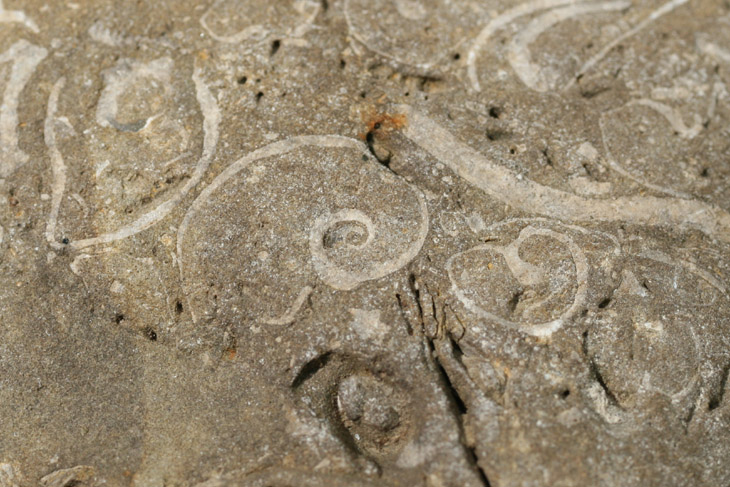
That one in the center is pretty obviously a spiral shell cut through the middle, too uniform to lend weight to anything else, but those surrounding it are a bit harder to fathom. These are in line with the time period of Central NY bedrock, where much of the sea life was not too developed yet and land life was only simple plants and the first terrestrial arthropods – we’re talking waaayyy before the dinosaurs, and even well before Tiktaalik. Here are a couple of links for Silurian (older) and Devonian periods. However, shellfish of this nature have existed ever since those periods as well, and their durable calcium shells are quite commonly preserved, so I can offer no confidence in the age of this rock.
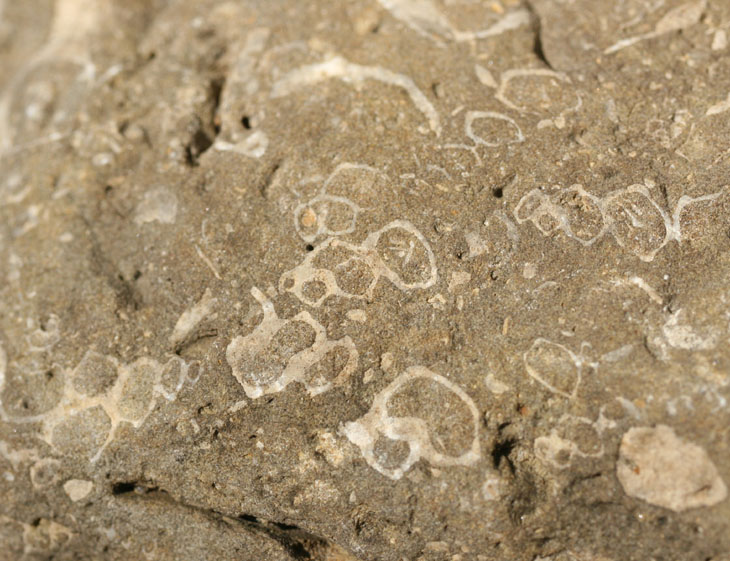
 When examining the fossils above, I thought I had an inkling of what they were, but now realize that I was wrong. I had suspected they were cross-sections of either the typical spiral “snail” shell or the conical kind, but neither of those would produce such shapes, so I’m presently stymied. And all bets are off for the examples to the right. Yes, I’ve already considered trying to free them from the matrix they’re within, but this may take some time; it’s definitely stone, the consistency of concrete, and isn’t going to come away easily. Telling, perhaps, is the stone visible in the middle of the rings above. While almost certainly just in shallow troughs, it hasn’t fallen free on its own, even through all of the erosion that has produced the cross-sections in the first place.
When examining the fossils above, I thought I had an inkling of what they were, but now realize that I was wrong. I had suspected they were cross-sections of either the typical spiral “snail” shell or the conical kind, but neither of those would produce such shapes, so I’m presently stymied. And all bets are off for the examples to the right. Yes, I’ve already considered trying to free them from the matrix they’re within, but this may take some time; it’s definitely stone, the consistency of concrete, and isn’t going to come away easily. Telling, perhaps, is the stone visible in the middle of the rings above. While almost certainly just in shallow troughs, it hasn’t fallen free on its own, even through all of the erosion that has produced the cross-sections in the first place.
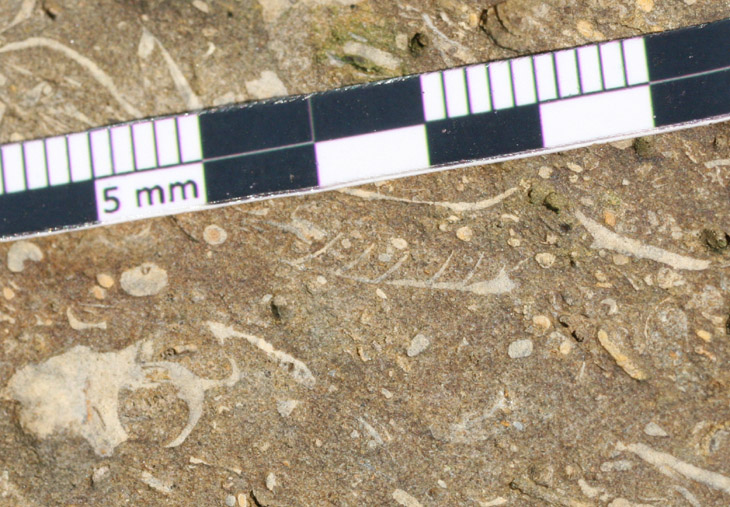
Your guess is as good as mine in these cases, probably better. There are a lot of not-quite-random shapes to be found in this one stone.
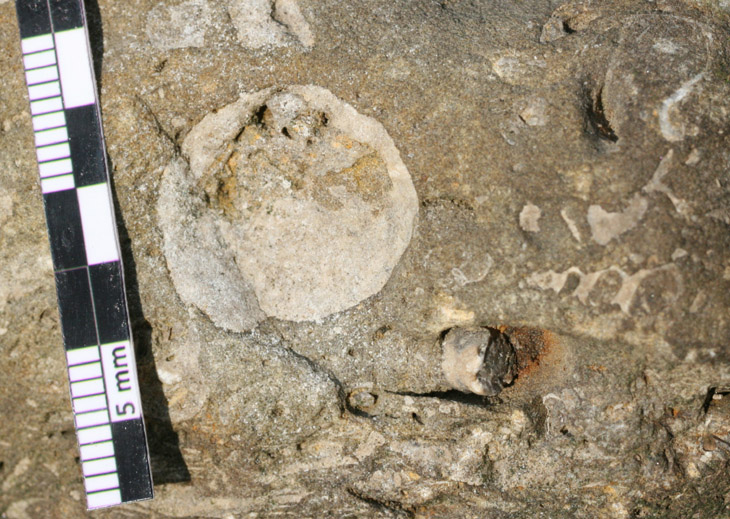
This one has a crucial detail, I believe. See the rod-like fossil to the right, with the rust stain? That very likely is rust, and is one of the ways to spot fossils in the first place. Iron is a great element in a bloodstream, and so living organisms tend to collect it in greater concentrations than average, and it remains trapped within the rock until exposed millions of years later. This is one of two such stains visible on my find.
But the coolest part came when I turned the stone over.
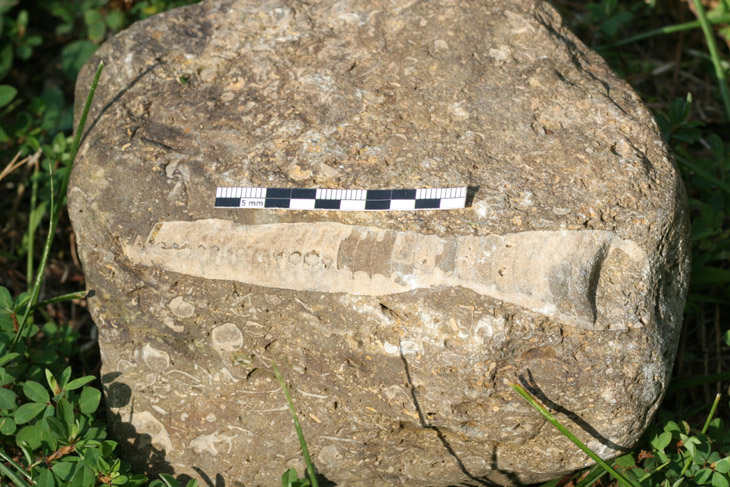
No, it’s definitely not a snake, and probably not anything closely resembling one either. My first guess is a type of coral, but perhaps a plant stem. While nearly all of the fossil traces to be found on this specimen are even with the surface, wearing down in equal amounts from erosion, there are still some ideas to be gleaned from examination and considering things in three dimensions.

For instance, there appears to be some sort of internal structure revealed in patches to be found in those segments, but it may not go very deep within, since the neighboring portions look like the structures might have already eroded away. If we assume (perhaps rashly) a uniform thickness of the organism, the places where it gets narrow probably means it curves deeper within the stone there. I initially thought that the shape of the worn-away segments just right of center gives some indication that the segments are convex, each bowed out, which is why the stone has that little curved shape along the bottom (from our perspective) of each segment; the problem with that is, such a shape is not reflected along the body of the whole organism, where it should also have shown. Along the top, there is a suggestion of some notch or indent in each. I am interpreting it that the stone also fills the hollow ‘body’ of the organism, largely because the segments still have very distinct separations, which shouldn’t be there if, for instance, the organism simply lies deeper within the stone and hasn’t been revealed yet in those sections. Of course, I could be entirely wrong; this isn’t exactly my area of expertise (nothing is, when it comes down to that.)
If I ever sit down to start digging it away with dental picks and actually make any progress, I’ll come back and show off what I found. In the meantime, if anyone finds a good resource on identifying such things (or personally knows a lot more about this than I,) feel free to chime in.
See also What I did over summer vacation.



















































